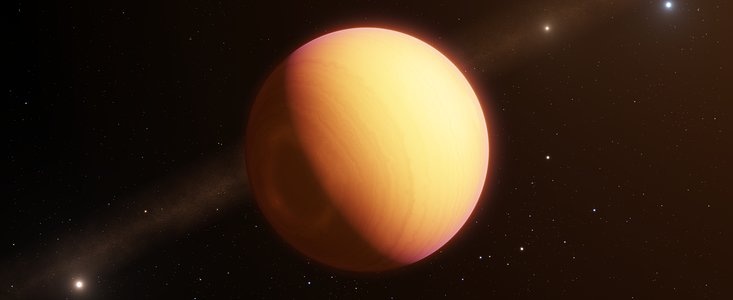Mar 28 2019
The first-ever direct observation of an exoplanet with the help of optical interferometry has been achieved by the GRAVITY instrument on ESO’s Very Large Telescope Interferometer (VLTI). This technique unraveled a complex exoplanetary atmosphere with clouds of silicates and iron whirling in a planet-wide storm.
 (Image credit: ESO/L. Calçada)
(Image credit: ESO/L. Calçada)
The method offers exceptional possibilities for the characterization of several exoplanets known at present. This outcome was reported in a letter in the Astronomy and Astrophysics journal on March 27th, 2019 by the GRAVITY Collaboration, in which observations of the exoplanet HR8799e with the help of optical interferometry have been presented. In 2010, this exoplanet was found to be orbiting the young main-sequence star HR8799, located about 129 light-years from Earth in the constellation of Pegasus.
The current outcome, which divulges new characteristics of HR8799e, needed an instrument with extremely high sensitivity and resolution. GRAVITY has the potential to employ ESO’s VLT’s four-unit telescopes to work in collaboration to mimic a single larger telescope with a method called interferometry. This forms a super-telescope—the VLTI—that gathers and accurately disentangles the light from HR8799e’s atmosphere and the light from its parent star.
HR8799e is a “super-Jupiter,” a celestial body unlike any other found in the Solar System, which is not just very massive but also considerably younger compared to any other planet orbiting the Sun. With an age of just 30 million years old, this infant exoplanet is sufficiently young to offer researchers an opportunity to gain insights on the formation of planets and planetary systems. The exoplanet is completely inhospitable—energy leftover from its formation and a strong greenhouse effect heat HR8799e to an aggressive temperature of approximately 1000 °C.
Optical interferometry has been used for the first time to unearth particulars of an exoplanet, and the new method offered a splendidly detailed spectrum of unparalleled quality—10 times more detailed compared to earlier observations. The measurements by the researchers allowed to uncover the composition of HR8799e’s atmosphere, which offered some surprises.
Our analysis showed that HR8799e has an atmosphere containing far more carbon monoxide than methane—something not expected from equilibrium chemistry. We can best explain this surprising result with high vertical winds within the atmosphere preventing the carbon monoxide from reacting with hydrogen to form methane.
Sylvestre Lacour, Team Leader and Researcher, CNRS at the Observatoire de Paris—PSL and the Max Planck Institute for Extraterrestrial Physics.
The researchers discovered that the atmosphere also includes clouds of silicate and iron dust. Upon combining with the excess of carbon monoxide, this indicates that HR8799e’s atmosphere forms part of a violent and colossal storm.
Our observations suggest a ball of gas illuminated from the interior, with rays of warm light swirling through stormy patches of dark clouds. Convection moves around the clouds of silicate and iron particles, which disaggregate and rain down into the interior. This paints a picture of a dynamic atmosphere of a giant exoplanet at birth, undergoing complex physical and chemical processes.
Sylvestre Lacour, Team Leader and Researcher, CNRS at the Observatoire de Paris—PSL and the Max Planck Institute for Extraterrestrial Physics.
This outcome builds on GRAVITY’s series of impressive discoveries, including breakthroughs like last year’s observation of gas whirling at a speed 30% that of light just outside the event horizon of the massive Black Hole in the Galactic Centre. It also offers an innovative way of observing exoplanets to the hitherto wide repository of techniques available to ESO’s telescopes and instruments—opening the door to much more remarkable discoveries.